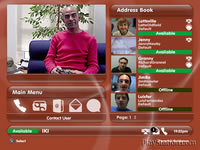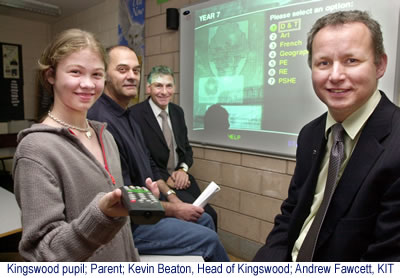It’s now over to the politicians. Nobody who has seen Flarion’s sales pitch has failed to be impressed by “what if?” this technology were available. Faster than 3G and covering more users at the same time, with far lower network latency – if we had this, there wouldn’t be all the discussion about WiFi phones. But the technology looked to be illegal.
Now, in a deal with Vodafone which covers metro Tokyo Flarion is going to get the test bed it needs to convince the world’s Governments to allow this technology in existing spectra.
The barrier to Flarion’s Flash-OFDM wireless is that the GSM and 3G network operators are licensed, pretty much anywhere in the world, to provide a voice service using specific technology on their masts. And Flarion offers a pure IP network, which is neither WCDMA nor GSM.
Of course, you can carry voice over IP networks; but the small print doesn’t appear to explicitly allow a voice network to be done this way, and often, specifically insists on GSM or WCDMA technology. And politicians are wary of buying into a new technology, because there are powerful lobbies threatening to take real money off them if they do.
The problem is that in all too many countries, huge sums have been raised in 3G phone auctions. If the various Governments who conducted these auctions suddenly rendered 3G obsolete by licensing a new system, the calls for refunds would be loud and strident.
On the other hand, if the mobile phone companies initiated the move, they’d be effectively conceding that they didn’t care about the original high-priced licence rip-off.
The trial is being described as low key and routine, by Vodafone: “Vodafone undertakes technical trials of emerging technologies to ensure we are well positioned to drive future research into mobile system solutions,” said today’s announcement. “Such programmes also enable Vodafone to respond quickly to commercial opportunities with specific market requirements should the need arise,” said Professor Michael Walker, Vodafone Group Research and Development Director.
The mobile broadband trial will start in mid 2004 and will cover metropolitan areas of Tokyo. Vodafone “will conduct field tests of Flarion’s system performance, user mobility, subscriber scalability, robustness, and transparent delivery of enterprise and consumer applications over an end-to-end IP network infrastructure.”
The trial will use Flarion’s commercially available FLASH-OFDM PC card modems for laptops and PDAs, to field test broadband Internet access, enterprise productivity applications, as well as gaming.
No mention of voice in that, but if it works as described, VoIP (voice over IP) trials will certainly be part of it. That was demonstrated at CTIA in Atlanta, in March.
But this isn’t the first public trial. In America, Nextel has a customer paying network in the high-tech nexus of Raleigh-Durham, and that has been public since mid last year. that network is a commercial which covers 1,300 square miles, in which there are 1.1 m people including residential, small businesses, and four of the largest American universities. The intention is to have 10,00 subscribers by end of this year, and there are around 130 mast sites. So it is a large substantial network.
The Vodafone trial, by contrast, will be just 7-8 sites; for purely technical testing.
Exactly how well Flash-OFDM works in a live application is an issue that many experts have debated. In theory, in Flarion’s white papers, FLASH (Fast Low-latency Access with Seamless Handoff) has an average downlink speed of 1.5 megabits per second – somewhere between five and six times the data rate of WCMDA 3G phones. Also in theory, it can handle far more simultaneous users, between two and three times, according to Flarion’s own estimates.
The technology is based on work done in Bell Labs, and inherited by Lucent, which spun Flarion off in February 2000. So – after Qualcomm – some industry analysts are very nervous about building an industry standard around a single intellectual property owner again.
The real appeal, however is that FLASH-OFDM allows for low latency access. Latency, the time wasted by a network while it processes data internally, is down to LAN standards.
The latency of a 2.5 G network can be enormous. The GPRS standard actually permits delays of over 10 seconds – 800 ms and above is the agreed specification. Ten seconds is not that unusual, if the user is moving from one cell to another. Nearly all Internet based software will assume the link is broken if delays on that scale occur, and will time out or crash.
Latency of WCDMA is far lower, but still can reach large fractions of a second. In an unloaded network it would be 250 ms; as you load the net, it can be one second and above.
Flarion has said that average sustained latency of Flash-OFDM is below 50 milliseconds, and can be far lower. This will be one key factor which Vodafone will evaluate in live trials. Trials in Europe with “an operator” (Flarion can’t disclose which) ran at 28 ms average.
Also, Vodafone will want to assess IP Quality of Service (QoS), and Flarion’s claims of “high spectral efficiency and full mobility” and “ubiquitous, LAN-like user experience” claims, too. Flarion categorises standard Third generation (3G) mobile networks as “circuit-switched, hierarchical architectures.” You are connected to a given end-point during the whole of a call, rather than sending packets into a true packet switched IP network, they say: consequently “there is tension between the design objectives and the current environment of the wired Internet and mobile voice networks. The resulting design compromises of circuit-switched networks, which are optimised for voice, impair their ability to deliver high-speed, low-latency data cost effectively.”
If Flarion is right, the big saving is cost to the operator. “The resulting high cost-per-megabyte of data delivery over circuit-switched based networks will prevent the emergence of mass-market wireless Internet access. An alternative approach, focusing directly on high speed, low cost and low latency wireless data delivery is required. Flarion, through its innovative FLASH-OFDM airlink, addresses the challenge of delivering affordable mobile broadband.”
Joe Barrett, EMEA marketing director at Flarion, said that the politics of Flash-OFDM isn’t as sensitive as some people think. “European regulations don’t have the same force as the original GSM Directive, when it comes to 3G,” he told NewsWireless. “In any case, the recommendations on which the contracts were based for 3G have now expired. The contracts do mandate whatever they say, but there’s no regulation requiring that they can’t be varied.”
And, he believes, European legislators are becoming less prescriptive.
“They want to ensure that different bands are used for the purpose intended, but they aren’t insisting on technology any more,” he said.
 Slowly and steadily, Sony is building on the usage and application of the ground-breaking EyeToy webcam add-on for their Playstation 2. The latest announcement is EyeToy:Chat, which expands the tool into a far more social area.
Slowly and steadily, Sony is building on the usage and application of the ground-breaking EyeToy webcam add-on for their Playstation 2. The latest announcement is EyeToy:Chat, which expands the tool into a far more social area. Clearly safety will be a big concern for parents and Sony’s London Studios, the original inventors of EyeToy, who developed Chat and have spent considerable efforts in trying to make the product as safe as possible. User will need to register with Playstation Net to use it and will only be bale to take part once they enter the PIN that is send to their home address. With Chat rooms being moderated and a clear processes for grievances Sony feels “‘EyeToy: Chat’ is one of the safest communication packages available on any system on the market.”
Clearly safety will be a big concern for parents and Sony’s London Studios, the original inventors of EyeToy, who developed Chat and have spent considerable efforts in trying to make the product as safe as possible. User will need to register with Playstation Net to use it and will only be bale to take part once they enter the PIN that is send to their home address. With Chat rooms being moderated and a clear processes for grievances Sony feels “‘EyeToy: Chat’ is one of the safest communication packages available on any system on the market.” Kevin Beaton, Head Teacher at the school explains why they wanted to get so involved in a service like this: “The rationale for the whole project is that the school becomes the local hub that is able to provide the surrounding community with access to digital services. Initially the focus will be on education, so that we can prove to everyone involved that the principle of on-demand access to information and interactive educational content really is viable.”
Kevin Beaton, Head Teacher at the school explains why they wanted to get so involved in a service like this: “The rationale for the whole project is that the school becomes the local hub that is able to provide the surrounding community with access to digital services. Initially the focus will be on education, so that we can prove to everyone involved that the principle of on-demand access to information and interactive educational content really is viable.”